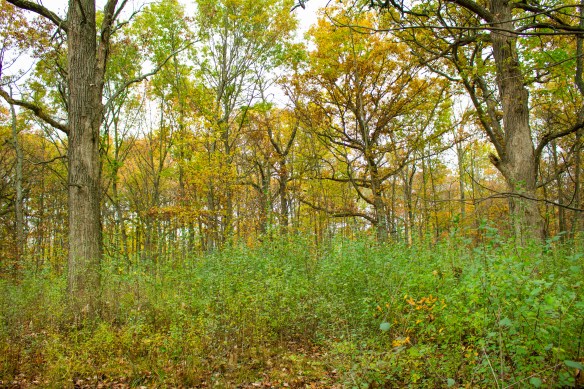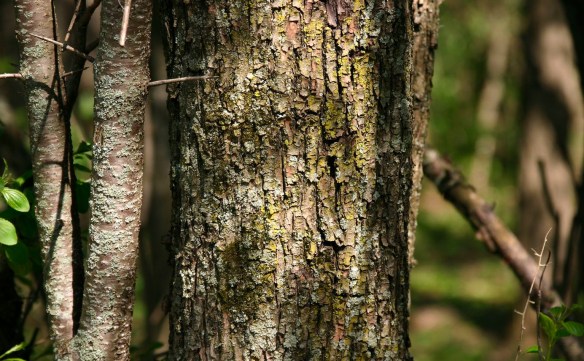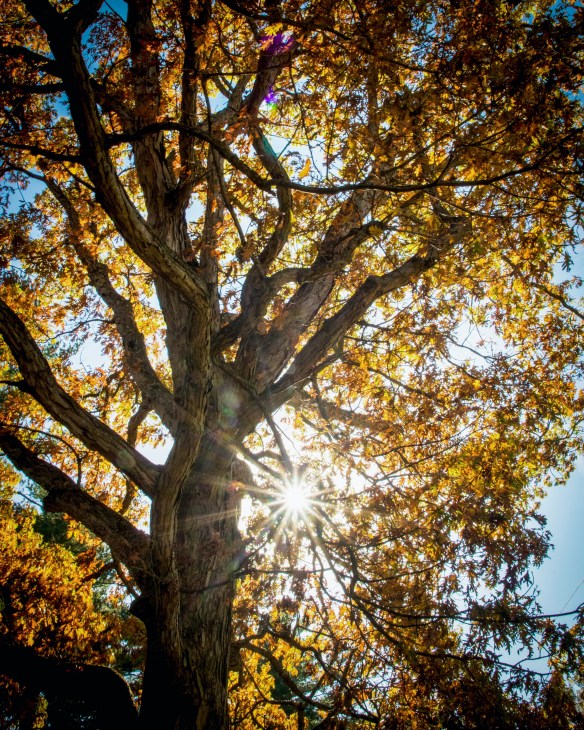Post by Brett Peto
Fall is my favorite season. I know it’s here on the first day I walk outside into the sort of air so crisp it makes your nose run instantly, somehow in a good way. Sunset shifts sooner. You opt for a sweater instead of a t-shirt and everything pumpkin-flavored becomes tastier than you remember. Best of all, the crowns of oaks, hickories, maples, and more across the Lake County Forest Preserves in Illinois change into their vibrant fall fashions.

But in the understory of many woodlands, yards, and neighborhoods, a thick ribbon of vegetation remains stubbornly green until late in the season—still photosynthesizing while other plants are preparing for winter. That’s the fall fashion of common, or European, buckthorn (Rhamnus cathartica).

Buckthorn is an invasive large shrub or small tree. Introduced to North America in the 1800s as an ornamental shrub and hedgerow, it soon escaped into natural areas and spread quickly. By the early 1900s, buckthorn had infiltrated much of the midwestern and northeastern United States.
In areas too wet for common buckthorn, another species—glossy buckthorn (Frangula alnus)—establishes itself. Buckthorn now makes up more than 40 percent of the tree canopy in Lake County, dwarfing all others.
I’ve found that Latin species names often seem deceptively harmless. Rhamnus cathartica doesn’t sound too threatening. Rhamnus is Late Latin for “a thorn bush” and cathartica derives from the Ancient Greek word kátharsis, meaning “cleansing” or “purification.”
Apart from the thorns, Rhamnus cathartica sounds benign, even slightly positive. Cleansing and purification are good, right?
The name fits the plant, but there are hidden thorns. The glossy black fruits of buckthorn have a diuretic, or laxative, effect on birds that eat them, so they’re expelled sooner than other fruits. This brings the seeds to new soil faster, where they remain viable for two to six years.



Not only do buckthorn leaves hang on longer in fall, they grow earlier in spring. The throngs of leaves, twigs, and branches form a dense layer several feet off the ground. This deprives native plants of sunlight, from ephemeral wildflowers such as large-flowered trillium (Trillium grandiflorum) to young oak seedlings.

Buckthorn also produces a chemical called emodin. Found in its fruits, leaves, and bark, and released by its roots, emodin deters herbivores from eating buckthorn leaves, protects unripe fruits from being eaten too early, and inhibits the growth of native plants and microorganisms nearby. That’s called allelopathy: one organism stunting the growth of another through chemical means.
Buckthorn leaves are high in nitrogen, as well. Upon their eventual descent, they decompose swiftly, changing nitrogen and pH levels in the soil. Over time, this typically leads to bare ground and increases the likelihood of erosion, which can expose the roots of any native plants that remain.
So what’s the result? Wide, deep patches of buckthorn…and not much else. Every time I need to hunch through a buckthorn patch, I’m appalled at how vulnerable the soil looks. It feels like entering a particularly desolate cave. Watch your footing. Savor every mote of light. Strain to hear sounds from outside, faint and distant, as if sent through a tin can on a string.

Buckthorn infestation is clearly harmful for native plants and wildlife, including the oak tree. The oak is a keystone species of our woodlands. Hundreds of species of birds, insects, butterflies, mammals, and plants depend on it for shelter, camouflage, reproduction, and nutrients.
Young oak seedlings need more sunlight and space to grow than other trees. Both are in short supply in buckthorn-dominated woodlands. Year by year, the canopy oak trees, many already more than a century old, age with few seedlings and saplings surviving to replace them.
Oak regeneration stalls. Countless acorns never push a taproot down or send a shoot up. The shoots that do go up wait for sunlight. We’re still in the cave.
This may be the present state of our natural areas, but it doesn’t have to be the future. October is Oak Awareness Month—OAKtober—in Illinois. Find a way to celebrate. Host a restoration workday. Take a walk through a woodland. Share photos and videos of your favorite oak on social media using #OAKtober.

Together, let’s start a new fall fashion this OAKtober: planning buckthorn removal for the winter, then planting an acorn or oak seedling.
Head into your yard and take stock of any buckthorn present. (Follow these identification tips.) If the amount looks overwhelming, prioritize. Start with the fruit-bearing plants. Mark them with colored flags, take photos, or sketch a map in a notebook.
Winter is the ideal time to remove buckthorn, as the frozen ground helps protect any nearby native plants from soil disturbance. Loppers and bow saws work well for small- and medium-sized buckthorn. Chainsaws may be needed for especially large buckthorn.

Cut the stem flat a few inches above the ground—imagine a soda can beside the stem for a good height. Immediately apply herbicide to the cut stump to prevent re-sprouting. Commercially available herbicides such as triclopyr and glyphosate are usually effective. Treat only the cut surface and follow all directions on the chemical label. Use an indicator dye or colored flags to mark the treated stumps. Remove the brush via burning or waste disposal. Contact your municipality about burning permits and local compost sites, or ask your waste management company about woody brush removal.
It’s important to follow up your initial removal efforts over the next few years. Without it, buckthorn seedlings will almost certainly grow in place of the plants you’ve eradicated, thanks to the durable seed source in the soil. Pull seedlings by hand or use a small hand tool as they appear.
Planting a mix of native trees, shrubs, and wildflowers can help control re-sprouting, as well. For privacy hedges, nannyberry (Viburnum lentago) and elderberry (Sambucus canadensis) are good native replacements to consider. For understory trees, perhaps choose American plum (Prunus americana) or downy hawthorn (Crataegus mollis). And for canopy trees, think about planting white oak (Quercus alba), swamp white oak (Quercus bicolor), or bur oak (Quercus macrocarpa).


Buckthorn removal is a long-term project; it will likely take several seasons for your home to become a buckthorn-free zone. Planting an oak is a long-term project, too—not for the time it takes to plant, but to grow.
But eventually, one fine fall to come, you’ll walk around your yard and see no thick ribbon of buckthorn green. You’ll peer through where the buckthorn once was, into a forest preserve or park or neighborhood. Then you’ll look up and see the burnished brown of oak leaves whose journey you helped along.
And that will be the ultimate fall fashion.

Want to learn more about the Illinois state tree, the white oak? Celebrate the Illinois Bicentennial (1818–2018) and learn the natural history of the white oak at Symbols of Illinois: White Oak on Sunday, November 11, 1:30–2:30 pm at Greenbelt Cultural Center (North Chicago). $2 residents/$4 nonresidents. All ages welcome. No registration required.

This is a great post. You’ve done an excellent job describing this challenge.
I cut my first buckthorn sometime in the mid-80’s, at a workday on a forest preserve. Since then I’ve seen this pest become the disaster it is today despite the unflagging efforts of many, many people. When I walk around my block I am discouraged by all the buckthorn I see growing in people’s hedgerows.
In addition to the methods you describe, I have a couple of suggestions. We know from pruning fruit trees that cutting in the winter will only encourage rampant growth. Cutting at June 21 will do the most to knock it back, as it will have used all of it’s stored energy from the previous year to grow. So if you can, this might be a more effective time to tackle them, and minimize the need for chemicals. Also, learn what the seedlings look like. So much easier to pull them up by the root before they get big. You won’t have the thorns scratching you, or the berries scattering, or the piles of brush to deal with.
Thanks for reading, melissabluefineart! We agree that pulling seedlings is far easier than removing mature shrubs. For timing, we tend to have greater success with herbicide application during fall and winter, as the sap is generally flowing down into the roots then. Cutting stumps in summer once, before fruiting in July, may make the re-sprouts more susceptible to herbicide by exhausting growth compounds from the roots, as you suggest.
We’re glad to hear you’ve joined the movement to eradicate buckthorn!
I would be hesitant about the recommendation of American plum. Planted three, decades ago, and have been fighting their invasion ever since. Couldn’t believe how they ran.
Thanks for your comment, Wallace. American plum does indeed proliferate quickly through root suckers and self-seeding. Removing suckers as they appear with mowing, hand-pulling, or small hand tools, if possible, can help control its spread. Alternate-leaved dogwood (Cornus alternifolia) or musclewood (Carpinus caroliniana) can serve as understory alternatives, as well.
Awesome information! Well said.
Thank you, Jan!
Nice article Brett!
Thanks, Sue! Glad you enjoyed it.